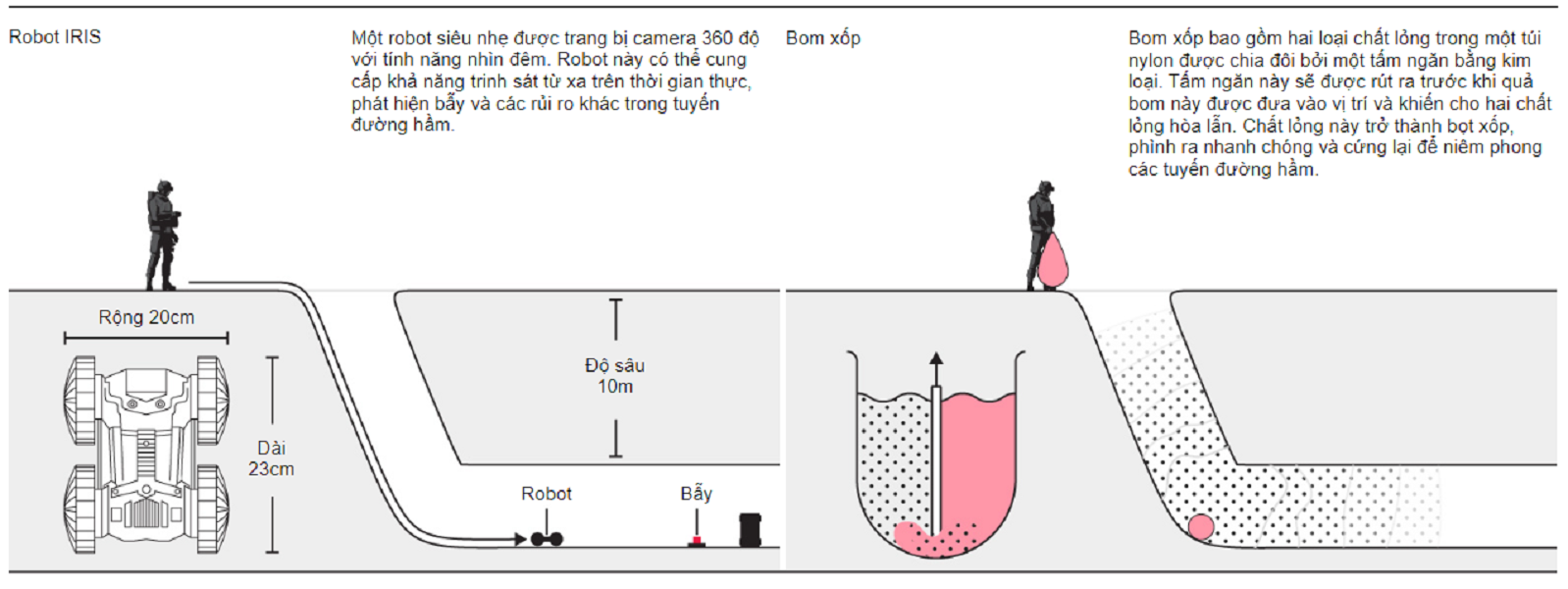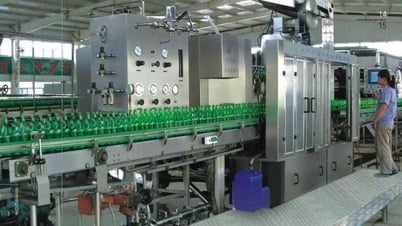The Israel Defense Forces (IDF) has been repeatedly testing this non-explosive chemical bomb, designed to seal off areas of tunnels that Hamas militants might use.
This type of bomb consists of a styrofoam block that suddenly expands and becomes harder, blocking the tunnel routes.
The IDF has not commented on this type of “foam bomb”.
Images of Israeli soldiers using this type of bomb in training have emerged since 2021. The army has built a simulation of the tunnel system at the Tze'Elim base on the border with Gaza.
Israeli soldiers are likely to face bloody battles in the “Gaza Metro” tunnels, which are believed to be hundreds of miles long and heavily booby-trapped, when they launch their planned invasion of Gaza.
This is where Hamas holds 200 hostages and where the organization's leadership will use it to survive the coming war.
Some soldiers were blinded after using bombs incorrectly.
This “foam bomb” would prevent soldiers from being ambushed as they travel deeper into the tunnels, by sealing off the tunnels that Hamas might use to ambush them.
The bomb has a plastic casing and a metal baffle that separates two liquid chemicals. When the baffle is removed, the two chemicals react as soldiers move the bomb into place.
Teams of experts in the IDF's engineering department were divided into tunnel reconnaissance teams and equipped with ground and airborne sensors, as well as ground-penetrating radars and drilling systems to detect tunnels.
They are also equipped with special equipment to be able to see in the tunnel.
Conventional night vision goggles require some form of ambient light to function effectively.
However, underground there is no natural light and soldiers must rely on thermography technology to see in the dark.
Several radios designed to operate in harsh underground environments have also been developed.
However, there are a number of factors that could potentially cause incidents in this arsenal. The “foam bomb,” which is technically a liquid emulsion, has a number of dangerous properties, and some Israeli soldiers have been blinded after using the liquid incorrectly.
Israel may use robots to help navigate tunnels, but so far these robots have had problems when used underground.
Some robots are controlled via signal wires that are laid behind the robot through a coil device.
Other robots are controlled via radio waves, but would need to have signal repeaters deployed along the way because radio signals dissipate very quickly underground.
Small drones for reconnaissance purposes that fit in the palm of your hand could also be used but would suffer from similar signal problems.
Israeli technology company Roboteam has developed IRIS, a small drone that can be controlled remotely.

Known to special forces as a "throwbot," it scans and relays images back to a controller, allowing the force to operate the device from a safe location.
Together with IRIS, they developed MTGR, a “micro-ground robot” that can climb stairs and is designed for soldiers to operate in buildings and caves.
Underground fighting is “more like fighting underwater than fighting in buildings,” said John Spencer, a former US major and chairman of urban warfare studies at the Modern Warfare Institute at West Point.
“What is used on land does not work properly or to the best of its ability underground. Special equipment is needed to enable soldiers to see, breathe, move, map, communicate and deploy lethal measures.”
Attacking the tunnels would threaten civilian lives
Hamas has integrated underground warfare into its overall military strategy. The tunnels, some built decades ago, are no longer just shelters but part of a broader plan to prepare for ambushes against Israeli forces above.
Many of the bunker areas are spread out under civilian structures, with entry and exit points being homes and other non-military buildings, making it extremely difficult for Israel to attack without drawing international condemnation.
A “standard” tunnel is about 2m high and 1m wide and can be built quickly. Sometimes they are reinforced with concrete and metal but are not too complicated.
Other underground areas also contained electricity, water and ventilation systems, and were used for command centres and rest stations, weapons storage, infiltration operations into Israel and access to secret missile launch sites.
In some places there are even said to have been small railway systems for transporting weapons and construction equipment.
Israel's last major attempt to destroy the system was in 2014, but the tunnel network has been rebuilt and further developed since then.
IDF military commanders will have to decide whether they want to render these structures useless, by means such as pouring concrete, as they did with Hezbollah-dug tunnels in the north of the country.
However, they may need to keep the structures intact, and eliminate Hamas fighters in order to retrieve the hostages. Conventional military responses to the tunnels, such as using explosives to destroy them or flooding them to render them useless, are probably impractical.
Nguyen Quang Minh (according to The Telegraph)
Source


![[Photo] Prime Minister Pham Minh Chinh chairs meeting on science and technology development](https://vphoto.vietnam.vn/thumb/1200x675/vietnam/resource/IMAGE/2025/5/17/ae80dd74c384439789b12013c738a045)


![[Photo] Readers line up to visit the photo exhibition and receive a special publication commemorating the 135th birthday of President Ho Chi Minh at Nhan Dan Newspaper](https://vphoto.vietnam.vn/thumb/1200x675/vietnam/resource/IMAGE/2025/5/17/85b3197fc6bd43e6a9ee4db15101005b)

![[Photo] More than 17,000 candidates participate in the 2025 SPT Competency Assessment Test of Hanoi National University of Education](https://vphoto.vietnam.vn/thumb/1200x675/vietnam/resource/IMAGE/2025/5/17/e538d9a1636c407cbb211b314e6303fd)


















![[Photo] Nearly 3,000 students moved by stories about soldiers](https://vphoto.vietnam.vn/thumb/1200x675/vietnam/resource/IMAGE/2025/5/17/21da57c8241e42438b423eaa37215e0e)






































































Comment (0)